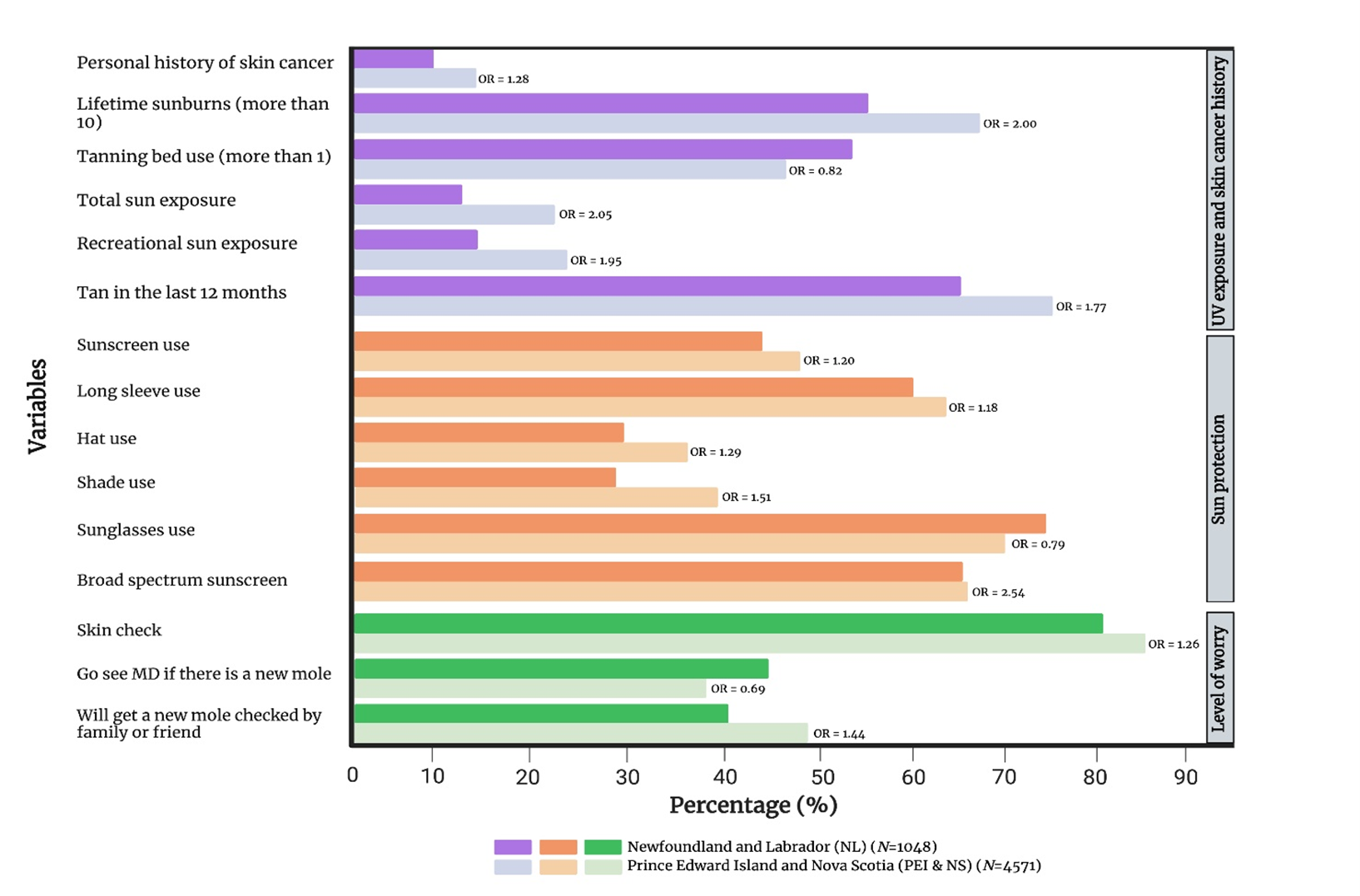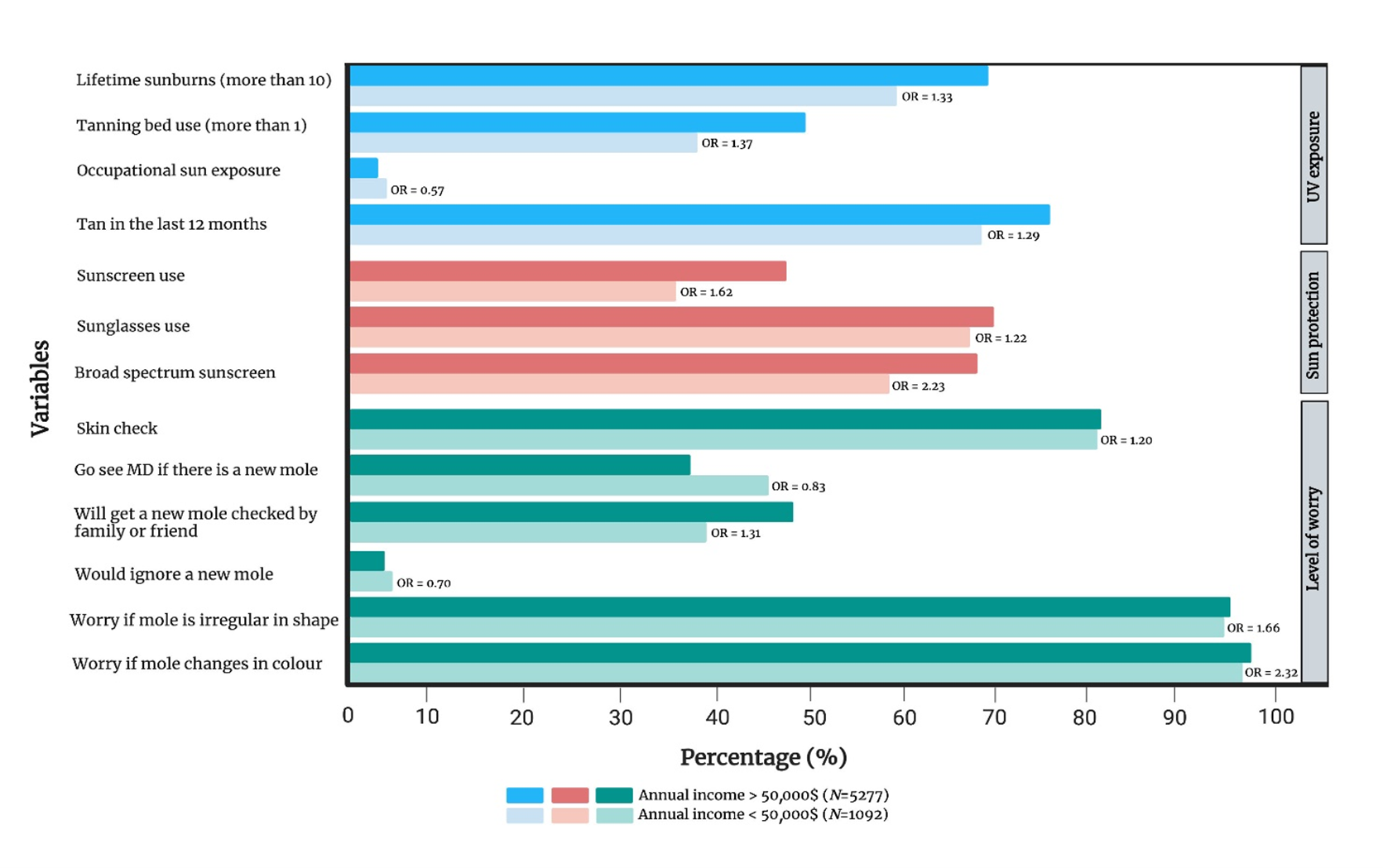Why men, wealthy people and maritime residents are more likely to develop skin cancer Â

A new led by Ď㽶ĘÓƵ examines why people living in Atlantic regions are more at-risk for developing melanoma than other Canadians, providing lessons on skin cancer prevention for the whole country. Â
Rates of melanoma, a deadly form of skin cancer, have been rising globally, including in Canada. Current estimates indicate that up to 1 in 3 Canadians will develop some form of skin cancer during their lifetime. While some Atlantic provinces such as Prince Edward Island (PEI) and Nova Scotia have the highest incidence rate of melanoma in the country, neighbouring provinces like New Brunswick and Newfoundland and Labrador have rates below or comparable to the Canadian average.Â
To find out why, the researchers compared UV exposure and behaviours among different groups in Atlantic Canada based on income, education, and gender, among other factors. Â

Comparison of UV exposure and skin cancer history, sun protection and level of worry between high-incidence (PEI/NS) and low-incidence (NL) provinces for cutaneous melanoma.Â
Higher-income individuals more at risk for melanomaÂ
The study found that higher-income individuals had an increased risk of melanoma. Risk factors contributing to this include more lifetime sun burns, tanning bed use, and being tanned. Similarly, individuals with university education had higher rates of recreational sun exposure but were less likely to use tanning beds. Â
“A higher socio-economic status is known to be associated with more vacations in sunny climates and recreational tanning, which likely ultimately drives melanoma incidence in this population,” highlights Dr. Ivan Litvinov, an Associate Professor in the Department of Medicine and Chair of the Dermatology Division at Ď㽶ĘÓƵ. Â
However, the study also showed that individuals earning less than $50,000 a year were more likely to work outdoors and experience occupational sun exposure, placing them at a higher risk of developing skin cancer. These findings suggest that policies to protect outdoor workers could help reduce melanoma risk, say the researchers. Â

Comparison of UV exposure and skin cancer history, sun protection and level of worry between individuals with a lower income (< CAD$50,000 annually) and those with a higher income (>CAD$50,000 annually). Â
Men are more skeptical of sunscreenÂ
Looking at differences between men and women, the researchers found that women had less sun exposure and practiced more sun protection compared to men. Men were more likely to report more lifetime sunburns as well as occupational and recreational sun exposure. They also had higher rates of melanoma and other skin cancers.Â
Nevertheless, women tended to wear fewer long-sleeve shirts and frequented tanning beds more. These behaviours, the researchers say, may explain findings in a previous study that show women are more likely to develop melanoma in their extremities. Â
When it comes to skin cancer prevention, their study found that men express more negative beliefs toward sunscreen use than women. Consistent with this, women were more concerned about new moles and were more likely to seek medical advice from a family physician. The researchers say these behavior patterns may account for the overall lower melanoma incidence and mortality in women.Â

Comparison of UV exposure and skin cancer history, sun protection and level of worry between men and women.Â
Putting sun protection knowledge into practice Â
The findings also show that people living in the most high-risk communities of PEI and Nova Scotia had more sunburns and sun exposure compared to people in regions like Newfoundland and Labrador. Surprisingly, those living in these high-risk communities had more knowledge of sun protection and melanoma awareness as well.Â
“To prevent skin cancer many Canadians really need to act on the knowledge they already have. Applying sunscreen is one of the effective ways to prevent skin cancer,” says Dr. Litvinov.Â
Public health efforts aimed at reducing skin cancer should be tailored to target specific demographic groups, the researchers say. “You need to have a different sun protection message when you’re talking to a single young man versus a mother of three children,” says Dr. Litvinov.Â
“Governments also have a direct role to play in combatting rising rates of melanoma. It’s projected that the financial burden of skin cancer to the Canadian healthcare system could rise to one billion annually by 2030,” he adds. “Canada should follow in the footsteps of many countries that have on sunscreen to promote their use.” Â
About the studyÂ
“” by François LagacĂ© et al. was published in Current Oncology.Â
About Ď㽶ĘÓƵ
Founded in 1821, Ď㽶ĘÓƵ is home to exceptional students, faculty, and staff from across Canada and around the world. It is consistently ranked as one of the top universities, both nationally and internationally. It is a world-renowned institution of higher learning with research activities spanning three campuses, 12 faculties, 14 professional schools, 300 programs of study and over 39,000 students, including more than 10,400 graduate students.
˛Ńł¦łŇľ±±ô±ô’s reaches back several decades and spans scales from local to global. The sustainability declarations that we have signed affirm our role in helping to shape a future where people and the planet can flourish.

